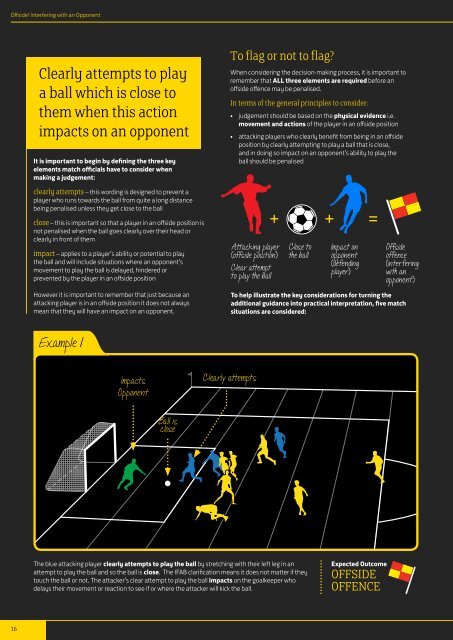Ken Aston MBE
10223_Referee-Magazine-Vol-26_LR
10223_Referee-Magazine-Vol-26_LR
- No tags were found...
You also want an ePaper? Increase the reach of your titles
YUMPU automatically turns print PDFs into web optimized ePapers that Google loves.
Offside! Interfering with an Opponent<br />
Clearly attempts to play<br />
a ball which is close to<br />
them when this action<br />
impacts on an opponent<br />
It is important to begin by defining the three key<br />
elements match officials have to consider when<br />
making a judgement:<br />
To flag or not to flag?<br />
When considering the decision-making process, it is important to<br />
remember that ALL three elements are required before an<br />
offside offence may be penalised.<br />
In terms of the general principles to consider:<br />
• judgement should be based on the physical evidence i.e.<br />
movement and actions of the player in an offside position<br />
• attacking players who clearly benefit from being in an offside<br />
position by clearly attempting to play a ball that is close,<br />
and in doing so impact on an opponent’s ability to play the<br />
ball should be penalised<br />
Example 2<br />
Clearly attempts<br />
Ball is<br />
close<br />
Impacts<br />
Opponent<br />
clearly attempts – this wording is designed to prevent a<br />
player who runs towards the ball from quite a long distance<br />
being penalised unless they get close to the ball<br />
close – this is important so that a player in an offside position is<br />
not penalised when the ball goes clearly over their head or<br />
clearly in front of them<br />
impact – applies to a player’s ability or potential to play<br />
the ball and will include situations where an opponent’s<br />
movement to play the ball is delayed, hindered or<br />
prevented by the player in an offside position<br />
However it is important to remember that just because an<br />
attacking player is in an offside position it does not always<br />
mean that they will have an impact on an opponent.<br />
Attacking player<br />
(offside position)<br />
Clear attempt<br />
to play the ball<br />
+ + =<br />
Close to<br />
the ball<br />
Impact on<br />
opponent<br />
(defending<br />
player)<br />
Offside<br />
offence<br />
(inter fering<br />
with an<br />
opponent)<br />
To help illustrate the key considerations for turning the<br />
additional guidance into practical interpretation, five match<br />
situations are considered:<br />
There is a clear attempt to play the ball by the blue player who stretches their left leg in an attempt to<br />
play the ball. No contact is made with the ball, but the ball is close. The player’s actions impact on an<br />
opponent - in this case the goalkeeper - who needs to delay their action to wait and see if the attacking<br />
player in an offside position touches or plays the ball.<br />
Expected Outcome<br />
OFFSIDE<br />
OFFENCE<br />
Example 1<br />
Example 3<br />
Impacts<br />
Opponent<br />
Clearly attempts<br />
Impacts<br />
Opponent<br />
Ball is<br />
close<br />
Clearly attempts<br />
Ball is<br />
close<br />
The blue attacking player clearly attempts to play the ball by stretching with their left leg in an<br />
attempt to play the ball and so the ball is close. The IFAB clarification means it does not matter if they<br />
touch the ball or not. The attacker’s clear attempt to play the ball impacts on the goalkeeper who<br />
delays their movement or reaction to see if or where the attacker will kick the ball.<br />
Expected Outcome<br />
OFFSIDE<br />
OFFENCE<br />
There is a clear attempt to play the ball by the red player, who jumps to make a clear attempt to play<br />
the ball with their head. No contact is made with the ball, but the ball is close. The player’s actions<br />
impact on an opponent, in this case the goalkeeper, who needs to delay their action to wait and see if<br />
the attacking player in an offside position touches or plays the ball.<br />
Expected Outcome<br />
OFFSIDE<br />
OFFENCE<br />
16<br />
17


